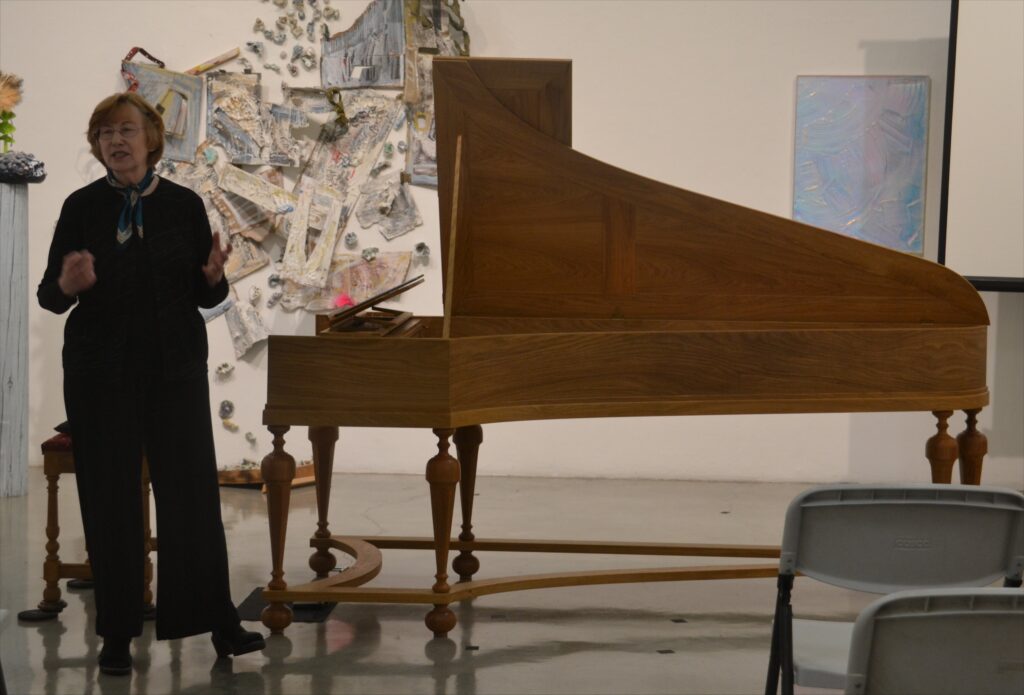
Saturday, September 16, 2023 – 2pm
St. John the Baptist Chapel at Oregon Episcopal School
6300 SW Nicol Rd, Portland – Campus Map
Online Video Premiere – Saturday, October 7, 2023 – 12 noon on the WEKA YouTube Channel
Carol lei Breckenridge will play JS Bach’s Chromatic Fantasy and Fugue, two works by CPE Bach, and ten sonatas by Domenico Scarlatti to demonstrate the versatile resources of the Silbermann fortepiano. This instrument was completed in 2022 by German builder, Kerstin Schwarz, and is a copy of a 1749 fortepiano by Gottfried Silbermann.
Fortepianos by Silbermann were known to JS Bach and CPE Bach, and similar fortepianos were known to Scarlatti. Their tone and action differ from the later Viennese pianos. This is a wonderful opportunity to see this type of instrument and hear its beautiful tone in person. To learn more about Silbermann’s work, watch a previously recorded video about this instrument on WEKA’s YouTube channel in which Kerstin Schwarz explains and demonstrates the action, and Carol lei Breckenridge plays excerpts by these three composers.
The Online Video Premiere of this event is scheduled for Saturday, October 7, 2023 at 12 noon on the WEKA YouTube channel and is followed by a Zoom reception. Both the performer and the builder will be available during the premiere and on Zoom to discuss the performance and the instrument with you. (The Zoom link will be available from the recital video.)
Admission
Free to WEKA Members
Free to 18 and under, and college students with ID
Children must be accompanied by an adult
General Admission $25 payable at the door with cash or check
The Chapel at Oregon Episcopal School is easily reached directly from the large, free school parking lot. Campus Map

About the Performer
Carol lei Breckenridge specializes in eighteenth-century music on clavichord and fortepiano. She has given numerous recitals and workshops, introducing students and audiences to early keyboards, including for The International Clavichord Symposium in Magnano, Italy, Cornell University, The Dutch Clavichord Society, the Historical Keyboard Society of North America, the Iowa City Early Keyboard Society, the Western Early Keyboard Association, the National Music Museum in Vermillion, South Dakota,, and many universities. Carol lei Breckenridge was the 2022 recipient of Early Music America’s Joan Benson Clavichord Award. She and colleagues Karen Hudson-Brown, Paul Irvin, and Philippe Litzler subsequently made a video, Introduction to the Clavichord, which can be found on WEKA’s YouTube channel.
With early study and degrees in modern piano, in the 1980’s she began to acquire historic keyboard copies of clavichord, harpsichord, and fortepiano, in order to discover how they illuminate repertoire of their time. Degrees in piano performance (B.M., M.M., D.M.A.) have been augmented with a 1997-98 Fellowship at Cornell University, studying fortepiano with Malcolm Bilson, as well as studies on harpsichord with Edward Parmentier and Joan Benson on clavichord. Professor Emerita from Central College in Pella, Iowa, Dr. Breckenridge now lives in the Portland area.
Brief History of the Piano
Around 1700, the first piano was invented in Florence, Italy, by the brilliant curator for the Medici, Bartolomeo Cristofori, who called it gravicembalo col piano e forte (harpsichord with soft and loud), having hammers that enabled dynamics by touch. Later, in the 1730’s in Germany, Gottfried Silbermann, Saxon builder of organs, harpsichords,and clavichords, began experimenting with building pianos. Apparently, in the 1740’s he obtained access to a Cristofori piano, and, realizing its action’s superiority, adopted it in exact detail. However, he placed Cristofori’s action in a larger case, increased the distance from hammer to string, used iron strings except for the bass, and hand stops for damper-raising, una corda, and a pantalon register. All these changes resulted in a more powerful tone, and arguably, the first true piano.
Emanuel Bach played Silbermann pianos when he was employed as accompanist and chamber musician at the court of Frederick the Great in Berlin. His father, Sebastian Bach, also knew Silbermann pianos, and was an agent for the sale of at least one, in 1749. When Sebastian visited his son in 1747 at the court in Potsdam, the King had him immediately brought to the music room and the new Silbermann piano. He was asked to improvise on a theme given by the King, which later became the basis for Bach’s The Musical Offering.
Domenico Scarlatti had access to Cristofori pianos at the Spanish court, as Queen Maria Barbara owned five, mostly Florentine (Cristofori-Ferrini) pianos, at the time of her death in 1758.
The basic tone quality of Cristofori and Silbermann pianos is very similar, particularly since they both have hammers made of rolled paper with a thin layer of leather on top. This strong, yet somewhat springy hammer, produces a tone quite different from later “Viennese” pianos. As with the far older clavichord (with a history dating back into the Middle Ages), the nuanced dynamics possible on Cristofori and Silbermann’s new invention afford a natural expressivity similar to that of the human voice, a quality of cantabile that became more and more the ideal in the eighteenth century.